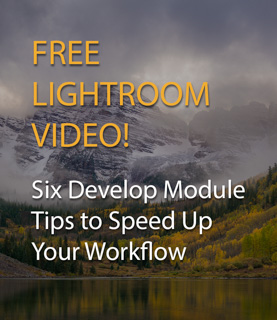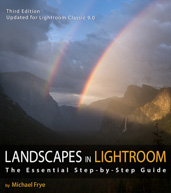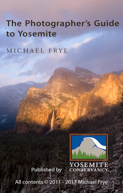In the Moment:
Michael Frye's Landscape Photography Blog
by Michael Frye | Feb 15, 2020 | Announcements
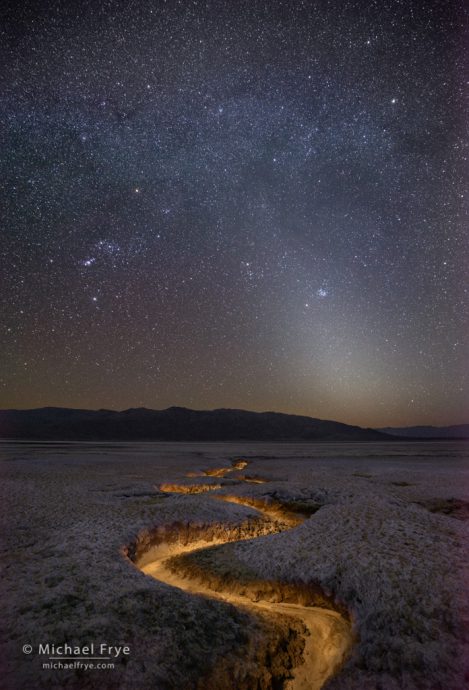
Stars, Orion, and zodiacal light over an eroded gully, Death Valley
I’ve had a full plate for the last month or so, with several workshops, followed by the Out of Yosemite conference. The conference was really fun, and I’ll have more to say about it soon. But first I wanted to let you know that Ian Plant just posted an interview with me on his YouTube channel. I thought Ian had some great questions. We discussed how I began my career as a wildlife photographer, my night photography, whether I have a personal style, and the balancing act between photographing the things you like while finding an audience for those images. And we talked about how I made some of my photographs, like the Death Valley image above. I hope you’ll enjoy the interview; here’s a link.
(more…)
by Michael Frye | Jan 19, 2020 | Light and Weather, Night Photography
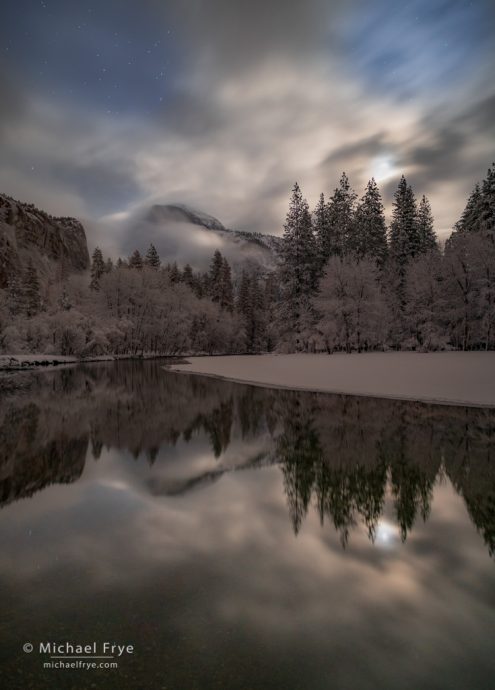
Half Dome and the Merced River by moonlight, Yosemite
We had a long stretch of rather dry weather here in central California, with just a few light showers here and there. But last week we finally got a decent storm. A cold front created a brief – but intense – period of precipitation on Thursday afternoon. At our house in Mariposa we saw strong winds prior to the cold front’s arrival, then the sky started dumping ice pellets, which quickly changed to heavy snow. None of the forecasts predicted snow at our elevation, but we got about four inches. After an hour or two the front passed, and the snowfall eased off into scattered snow showers.
Of course I watched the weather closely to see when this brief storm might clear. All the forecasts and models predicted showers lingering through the evening, and skies clearing sometime after midnight – but well before sunrise. That meant it was unlikely there would still be any mist at sunrise, so my best bet to photograph a snowy clearing storm was to go up to Yosemite Valley during the night. A half-full moon was due to rise just after midnight, so that could provide some interesting light during those wee hours.
(more…)
by Michael Frye | Jan 12, 2020 | Light and Weather
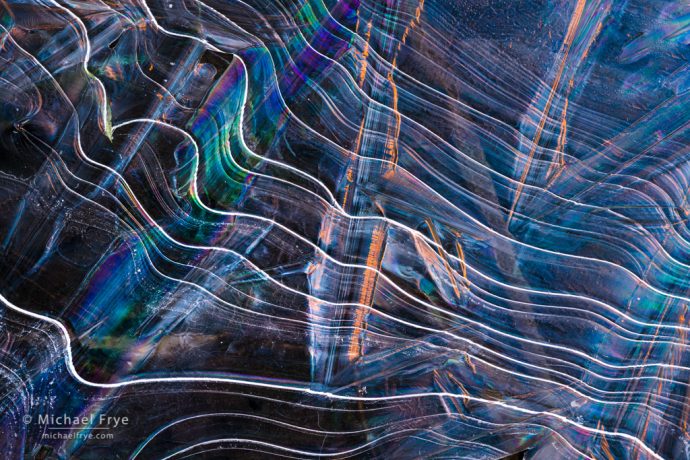
Ice and reflections, Yosemite. The gold color comes from reflections of sunlit cliffs, while I used a polarizing filter to bring out the prism effects in the ice. 168mm, 3 seconds at f/16, ISO 320; focus-stacked and blended with Helicon Focus.
I love photographing ice. It’s highly photogenic stuff, with lots of interesting patterns, and crystal facets that catch and reflect the light in beautiful ways.
During our recent workshop in Yosemite Valley temperatures were cold enough to create some wonderful ice formations along the Merced River, next to Bridalveil Fall, and in some of the creeks, so of course we had to make time to photograph the ice. We were often looking for places and angles where ice in the shade would catch golden reflections from sunlit cliffs across the valley, adding a splash of color to the patterns. And in some spots, with the right kind of ice, in the right light, we could see prism effects in the ice through a polarizing filter.
(more…)
by Michael Frye | Jan 4, 2020 | Announcements
The votes are all in and counted, and here are my top photographs of 2019!
We had a great response this year: over 360 people looked through my initial selection of 44 images and voted for their favorites here on the blog, Facebook, Instagram, and through email. A big thank you to everyone who took the time to look through these photographs and voice your opinions! I also really appreciate all the kind words so many people included with their votes. I wish I could respond to every comment and email, but please know that I’ve read them all and am very grateful for all your support. And also, many thanks to my wonderful assistant Claudia who tallied all those votes!
(more…)
by Michael Frye | Dec 31, 2019 | Announcements
Note: I’ve closed comments on this post because the voting deadline has passed. I’ll be posting the results soon!
Happy New Year!
It’s become a New Year’s tradition on this blog to pick my best images from the past year, and once again I’m inviting you to help me make these difficult choices. I’ve posted 44 of my best photographs from 2019 below, in chronological order. After you look through these, please post a comment listing your ten favorites.
You don’t have to list your ten favorites in any order, or even name them – just numbers will do. (The numbers are in the captions underneath the photographs. Also, you can click on the images to see them larger.) Once the votes are in I’ll post the top ten or twelve on this blog, and submit the final group to Jim Goldstein’s blog project, where he’ll be showcasing the best images of the year from over 300 photographers.
(more…)
by Michael Frye | Dec 29, 2019 | Light and Weather
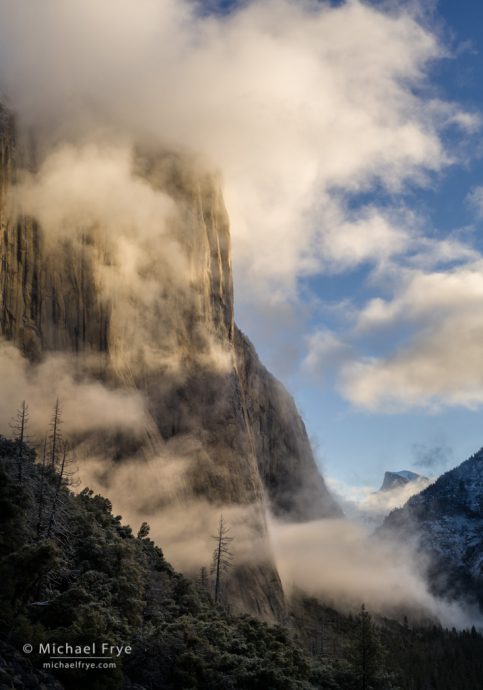
Half Dome and El Capitan during a clearing storm, Yosemite
We’ve seen a pretty active weather pattern here in California since late November. There haven’t been any big storms, but rather a series of smaller systems. Each dose of precipitation brings a chance to photograph a clearing storm – if the timing is right. And the timing has been perfect a few times.
My last post featured a sunrise clearing storm on Christmas Eve. The photographs in this post were actually made about a week before that, when another small weather system cleared just before sunrise.
(more…)
by Michael Frye | Dec 24, 2019 | Announcements
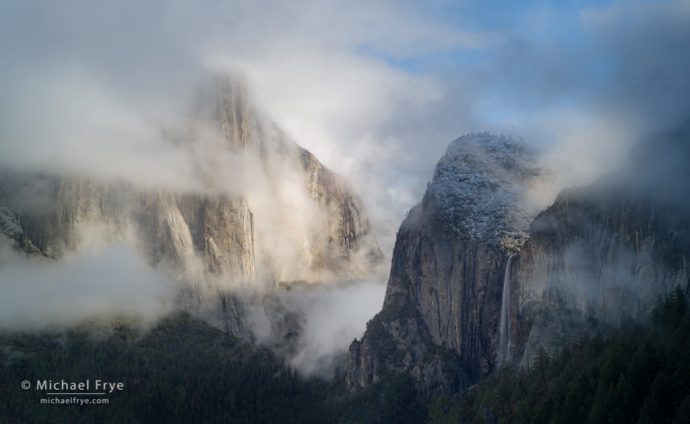
Bridalveil Fall and El Capitan, sunrise, Yosemite
For Claudia and me, Christmas came a little early. We made another early-morning journey to Yosemite Valley today, and got to see and photograph a beautiful, misty, clearing storm. I feel so fortunate to have lived close to this amazing place for 35 years, and to see it in every mood and season.
Claudia and I hope your holiday season is filled with wonderful experiences with family and friends. Merry Christmas and Happy Hanukkah!
— Michael Frye
by Michael Frye | Dec 22, 2019 | Light and Weather
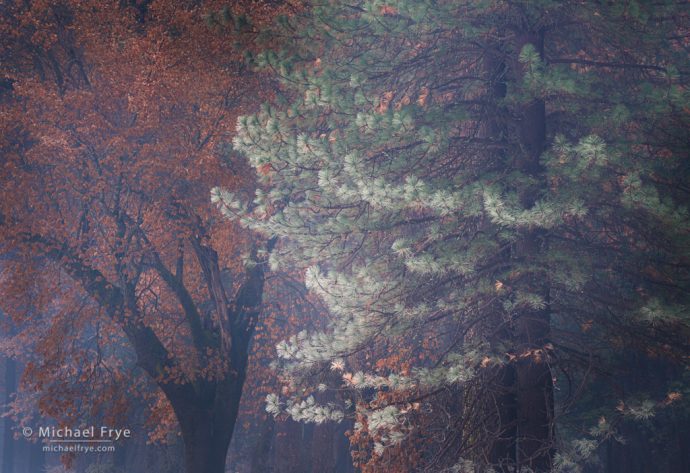
Oak and frost-tipped ponderosa pine, Yosemite. We walked to a spot along the Merced River, then decided to check out a nearby meadow, where we found some mist, and even better, beautifully-frosted trees. This juxtaposition of a frost-tipped pine and oak caught my eye. 163mm, 1/3 sec. at f/16, ISO 100.
It’s easy to view landscapes as permanent and unchanging, since the major components, like mountains rivers, lakes, etc., change slowly, at a pace measured in thousands of years – too slowly for us short-lived animals to perceive directly. The geologic evidence tells us that the land has changed – dramatically – and will continue to change, but I think for most people that’s an intellectual understanding, and doesn’t really affect the way we perceive and experience the world around us.
(more…)
by Michael Frye | Dec 15, 2019 | Light and Weather
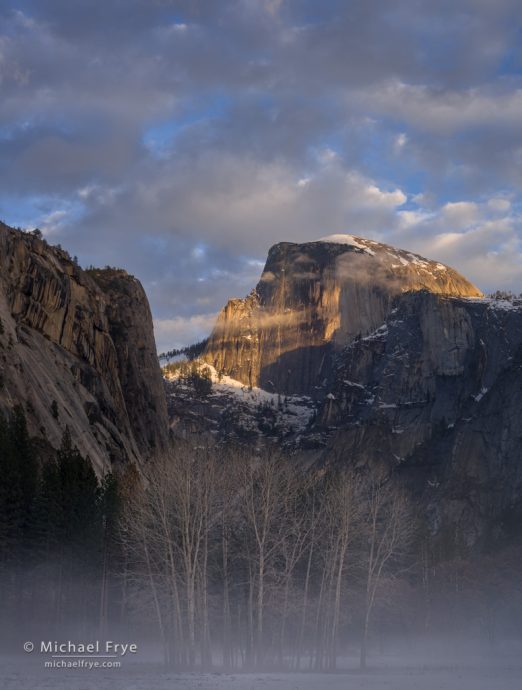
Half Dome, winter sunset, Yosemite. Incoming clouds prompted me to head to this spot to photograph Half Dome; luckily the sun broke through a gap in the clouds at the right moment. 50mm, 1/45th sec. at f/11, ISO 100.
Our exceptionally dry autumn gave way to a series of storms recently, with lots of interesting photography weather.
During our recent workshop every day seemed to bring a new opportunity. The first day it was a clearing storm. The next day it was ice patterns with gold reflections. We photographed the moon rising next to Half Dome – twice – plus misty meadows, backlit oaks, and frosted pines. It was a lot of fun.
(more…)
by Michael Frye | Dec 1, 2019 | Light and Weather, Night Photography
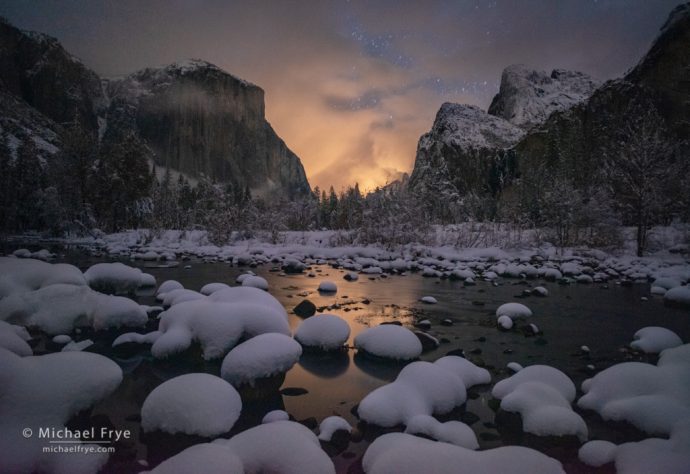
Snowy night along the Merced River, Yosemite. 20mm, 20 seconds at f/2.5, ISO 6400.
I’m not sure who decided that the winter solstice should be the first official day of winter, but I think that official designation is rather absurd. Winter has definitely arrived in many parts of the country, whether it’s official or not, including here in the Sierra. This past week Yosemite got its first precipitation in months, in the form of a cold storm that dropped over a foot of snow on the valley floor.
The snow began on Tuesday, and I kept my eye on the weather, of course, hoping to photograph the storm clearing, and looking for potential rifts in the clouds. Judging by satellite images, some stars might have appeared during the wee hours of Wednesday morning, but that was just a brief break before the clouds closed in again. Late Friday morning the sun finally started to poke through the clouds, so Claudia and I headed up to the valley.
(more…)









